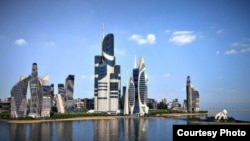The weight of the traditional steel cable that hoists today's elevators has prevented them going any higher than 500 meters in one run.
That means that people going up and down inside the world's tallest building, Dubai's 828-meter-high Burj Khalifa tower, need to switch lifts to go above the top mark.
But in London this week one of the world's leaders in the elevator industry, Finland’s Kone, unveiled its new UltraRope.
Kone President and CEO Matti Alahuhta claims this innovation will "revolutionize the elevator industry for the tallest segment of buildings across the globe."
"Kone has an impressive record of new industry innovations," he says. "This is again a major, new breakthrough. And the long-term business opportunities, they indeed look very, very interesting."
Kone says UltraRope will enable elevators to travel one kilometer -- twice as high as what is possible with today's technology.
Instead of the interwound steel hawsers currently used, UltraRope is more ribbon- or tape-like in form. The hoisting line is composed of a carbon fiber core covered in a high-friction coating.
Massive 'Breakthrough'
An elevator car is moved by multiple reels of UltraRope that run into a hoisting machine at the top of the shaft.
Kone says UltraRope does not require any lubrication and is less sensitive to building sway in high winds -- something that can cause elevators to shut down.
WATCH: The revolutionary new UltraRope carbon fiber for elevators
In addition, UltraRope is said to last twice as long as conventional steel ropes and its low weight results in dramatic cuts in energy consumption.
According to the Finnish firm, UltraRope would reduce electrical power consumption by 15 percent on an elevator traveling 500 meters. The claimed energy cuts rise to 45 percent for a height of 800 meters.
There was no word, however, on the cost of UltraRope and the associated machinery.
UltraRope has been endorsed by Antony Wood, executive director of the Council on Tall Buildings and Urban Habitat in Chicago.
"I think it's the biggest single breakthrough in the elevator industry since the advent of the safety elevator 150 years ago," he said. "It's going to enable more efficient, higher buildings in the places that warrant those buildings, but it's going to result in better energy efficiency in all tall buildings around the world."
UltraRope could open up new possibilities in building design as architects are drawing increasingly tall skyscrapers.
While there are currently three buildings in the world that top the 500-meter mark, there are at least 20 such buildings on architects' drawing boards, and more expected as megacities proliferate.
The new technology could be used in the Azerbaijan Tower, which is expected to be the tallest in the world.
Construction of the $3 billion, 1,050-meter building on the artificial Khazar Islands south of Baku is scheduled to start in 2015.
That means that people going up and down inside the world's tallest building, Dubai's 828-meter-high Burj Khalifa tower, need to switch lifts to go above the top mark.
But in London this week one of the world's leaders in the elevator industry, Finland’s Kone, unveiled its new UltraRope.
Kone President and CEO Matti Alahuhta claims this innovation will "revolutionize the elevator industry for the tallest segment of buildings across the globe."
"Kone has an impressive record of new industry innovations," he says. "This is again a major, new breakthrough. And the long-term business opportunities, they indeed look very, very interesting."
Kone says UltraRope will enable elevators to travel one kilometer -- twice as high as what is possible with today's technology.
Instead of the interwound steel hawsers currently used, UltraRope is more ribbon- or tape-like in form. The hoisting line is composed of a carbon fiber core covered in a high-friction coating.
Massive 'Breakthrough'
An elevator car is moved by multiple reels of UltraRope that run into a hoisting machine at the top of the shaft.
Kone says UltraRope does not require any lubrication and is less sensitive to building sway in high winds -- something that can cause elevators to shut down.
WATCH: The revolutionary new UltraRope carbon fiber for elevators
In addition, UltraRope is said to last twice as long as conventional steel ropes and its low weight results in dramatic cuts in energy consumption.
According to the Finnish firm, UltraRope would reduce electrical power consumption by 15 percent on an elevator traveling 500 meters. The claimed energy cuts rise to 45 percent for a height of 800 meters.
There was no word, however, on the cost of UltraRope and the associated machinery.
UltraRope has been endorsed by Antony Wood, executive director of the Council on Tall Buildings and Urban Habitat in Chicago.
"I think it's the biggest single breakthrough in the elevator industry since the advent of the safety elevator 150 years ago," he said. "It's going to enable more efficient, higher buildings in the places that warrant those buildings, but it's going to result in better energy efficiency in all tall buildings around the world."
UltraRope could open up new possibilities in building design as architects are drawing increasingly tall skyscrapers.
While there are currently three buildings in the world that top the 500-meter mark, there are at least 20 such buildings on architects' drawing boards, and more expected as megacities proliferate.
The new technology could be used in the Azerbaijan Tower, which is expected to be the tallest in the world.
Construction of the $3 billion, 1,050-meter building on the artificial Khazar Islands south of Baku is scheduled to start in 2015.















